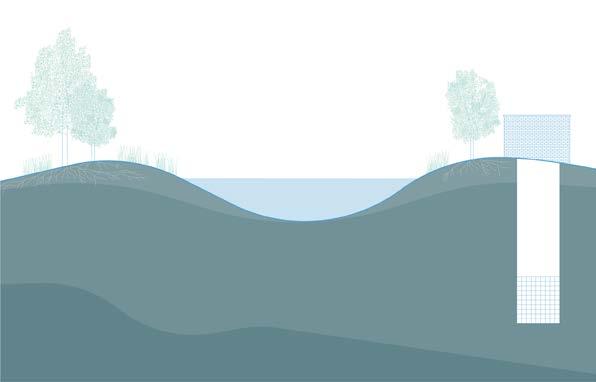
3 minute read
Deconstruct to Reconstruct
from Canvey Concept
Topic Research Deconstruct to Reconstruct
The Canvey Concept uses a proactive strategy to combat the changes that this island will go through in the next 50 to 100 years. Orchestrating a set of options now will allow the island to take control of its future rather than have it decided for it. To understand what is possible, it will be helpful to look at (1) how to deconstruct a home and what materials might be valuable to use, (2) how to treat edge conditions between land and water to protect what is on the inside, (3) solutions to mending the relationship the citizens have with water and being able to use it as a resource.
Advertisement
Demolishing a home is an expensive and resourceheavy process. According to Design for Deconstruction and Materials Reuse, Bradley Guy says that 85-95% of a home can be either reused or recycled (Guy & Shell, 2006), but most of the time, buildings are torn down, and the majority of materials end up in a landfill. In order to salvage that much material from a home, it has to be surgically taken apart, which costs more upfront. In the long run, it is better for the environment and keeps materials in a more circular lifecycle.
How to deconstruct a house (HomeServe, 2021) and what

materials are useable?
Shingles and underlayment on the roof Shingles are sometimes reusable, but roof underlayment is not
Skip sheathing and plywood
Wood can be reused
Interior fixtures (plumbing, electrical, doors, windows, cabinetry and flooring)
Plumbing and electricity cannot be salvaged, but doors, windows, cabinets, and flooring can be
Drywall and plaster
Drywall can be recycled, but plaster cannot be recycled
Brick and exterior siding
Bricks can be recycled if taken apart carefully
Load-bearing structure
Usually made of wood or steel, which can both be reused
It can be broken up and reused or stay in place for new uses
Edge Conditions
Island communities have unique ways of treating their edges. Canvey Island has chosen to fortify its edge by adding a concrete barrier between the town and the sea. When walking through town, people cannot even see the water as much of the land is below or at sea level, and the sea wall measures approximately 4 to 6 meters when coupled with the accompanying hill constructed on the town side.
There are many more interesting and aesthetically pleasing examples of sea walls throughout the world. Most notably, the way the Netherlands and Denmark negotiate their relationship with the sea is beautiful and functional at the same time.
Some places are even using filter banks to embrace the water surrounding their land and use it. In a world that will witness rising sea levels, bringing more water into the land, these types of systems could be helpful for more self-sustainable communities.
A bank filter naturally filters water through layers of soil. The fresh groundwater is then extracted from the earth using a large well.
NORDHAVN, COPENHAGEN,
Hard edge with added recreational value, including swimming infrastructure and places for people to sit silt + clay sand + gravel bedrock river channel
Gentle hills and diverse lawn meadows allow people to get close to the water.
Rocky edges made of rubble create excellent conditions for wildflowers and also make good foundations for linear pathways
ARKADIEN
Houses back right up to the water and have little decks for people to get their feet wet local flowpaths through porous sand + gravel well well screen ground water dilution regional flowpaths
Desalination Natural Water Treatment Study
As waters rise and the sea creeps inland, many countries are considering conditioning ocean water for their communities. However, the process has a high economic and environmental cost, as traditional desalination usually involves large industrial plants that use energy resources and take up space. Communities like Canvey Island could adopt some of these strategies to become more self-sustainable, but this would require a significant initial investment. Below outlines the general process that water has to go through to become usable:
Abstraction seawater enters into an pipe underwater
In a study about wastewater treatment, wetland plants were tested alongside different layered soils to filter water naturally. The following diagrams show a few tests that used gravel, sand and a mixture of the two and their outcomes. (Sosthene, et al. 2018)
5mm Gravel
10mm Gravel
25mm Gravel
Porous cloth
Outgoing water Salinity
Pre-treatment in order to filter solid material out, chemicals are added that cause them to stick together
Desalination to remove impurities the water is pushed through a membrane with tiny holes in it
Treated water conditioning
essential minerals are returned to the water and treated to meet water quality standards
Waste handling unused water is cleaned and returned to the ocean. Any solid waste is sent to a landfill
Brine release since the waste water has high levels of salt, they are discharged deep at sea for better dilution
0.15mm Sand
0.35mm Sand
0.60mm Sand
Porous cloth
Outgoing water
Salinity
0.15mm Sand
0.35mm Sand
0.60mm Sand
5mm Gravel
10mm Gravel
25mm Gravel
Porous cloth
Outgoing water
Salinity
Accumulation – halophytes have the ability to extract soil sodium and chlorine in their vacuoles
Salt excretion – some plants have salt glands to secrete excess salt out of the cell in the form of salt crystal
3 Exclusion – some plants have an ultra-filtration mechanism to avoid sodium uptake






